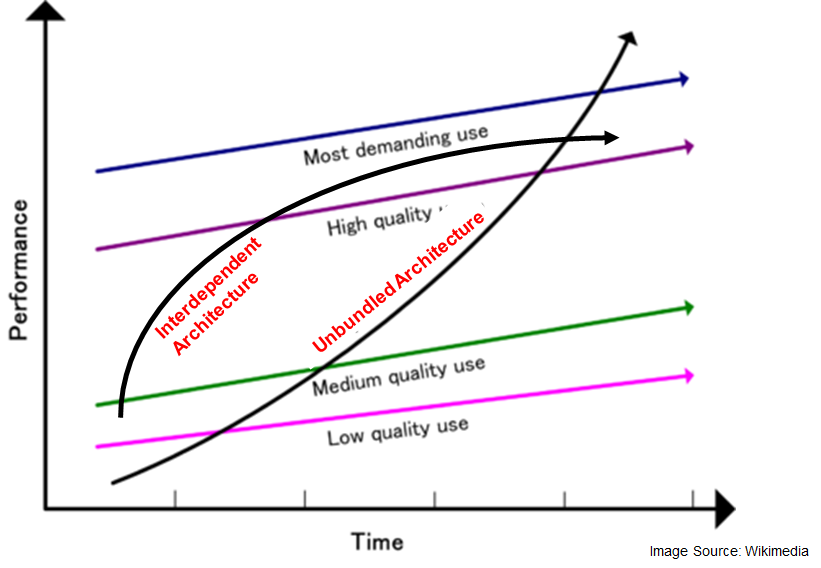
I will start with my response. Please feel free to add yours, and I will include it in the group blog post. While anyone is free to answer this question, I’m particularly interested in hearing answers from for those of you who have used unbundled components in your programs (like courseware, student coaches, outsourced components, etc.).
We have used various forms of courseware extensively in our courses: McGraw Hill’s Learnsmart, Saylor Academy’s open course, Christian curriculum from TUMI, MOOCs, etc. On one level, using unbundled components is not controversial as nearly all Christian universities will use secular books and YouTube videos in some of their courses.
- Group A: Courses not requiring faith integration like math and accounting. These are easiest to use secular third party materials like MOOCs and courseware. We have determined that for these courses, the cost of losing modularity by of creating surface level faith-integration (prayer or devotional at beginning of each week) is not worth the benefit. We have no problem essentially outsourcing these modules. We are also actively using GC4 to create paths for transfer credit for these unbundled components whether MOOCs or Microdegrees. I believe that while there is some loss in not always integrating faith in Group A courses, there is a dramatic cost benefit.
- Group B: Courses requiring significant faith integration like social entrepreneurship. For these courses, we design the overall course, but will include large modules such as books and MOOCs.
- Group C: Courses requiring intensive faith-integration like Theology of Work. For these courses, we typically design the vast majority of the course ourselves and are very intentional about how these courses support our degree paths.
- Transformative Experience. Churches and ministries might transform, but they are not transform in a way that is very well integrated with courses. This can be addressed with effective partnerships, training and end-to-end system design.
- Metacognition and Skills. Coaches, mentors and internships might help with metacognition and skills, but they also have very limited integration with what the student is learning in their courses. This can be addressed with effective partnerships, training and end-to-end system design.
- Access to opportunities. Often, courses may not be aligned with industry certifications or employer requirements. This can be addressed with effective partnerships, training and end-to-end system design. Similarly, the degree is a very non-transparent limiting way to represent a student’s capabilities. This can be address by intentionally designing a program so that students develop their public digital protfolio and LinkedIn profile as a part of their degree requirements.
- Knowledge acquisition. If courses come from disparate sources and values, there needs to be much more intentional design that the “lego pieces” fit together into a coherent whole.
- Gold Tier (Apple’s iPhone). These will be largely vertically integrated. These programs will have designs are tightly integrated and have more constraints and higher quality standards at all levels including entrance requirements.
- Silver Tier (Apple’s Android). This still requires an integrated design, but will provide more flexibility and quality standards that might adapt to different contexts and markets. Ultimately this is the tier that City Vision is trying to play at.
- Bronze Tier (unbundled moocs). The bronze would essentially be largely unbundled components, that have been reassembled with very loosely connected components. GC4 is working to play at this tier
Often in architectures, tight integration produces better quality in the short term (5-10 years), while more modular system usually match or exceed the quality of the integrated m
odel in the long term (10+) years. For example, many recent reviews I’ve seen of the more tightly integrated Android Phones (like Google Pixil) are showing it matching or exceeding iPhone, but still most android phones are not at that level of quality. Android now has 86.2% global market share vs. 12.9 for iPhone.
 I expect that education will play out in a similar way for higher education. A pattern seen in hundreds of industries is shown in the adjacent diagram. A veritcally integrated provider comes out with a superior solution (Mac/iPhone), then later a horizontal solution comes along that gradually gains market share (PCs/Android). There are obviously complexities to this in that there are particularities in some markets (and stages of market development) that lend themselves toward vertical integration. That is why the playout of Apple Macs vs. PC/Microsoft has been different between iPhone vs. Android (so far) because the level of usability of consumer electronics lend themselves toward vertically integrated solutions. Obviously the degree of vertical integration is a spectrum. Apple is considered a vertically integrated company, but it still selects horizontal component manufacturers to source many levels of its product. I think the key is the level of integration vs. modularity.
I expect that education will play out in a similar way for higher education. A pattern seen in hundreds of industries is shown in the adjacent diagram. A veritcally integrated provider comes out with a superior solution (Mac/iPhone), then later a horizontal solution comes along that gradually gains market share (PCs/Android). There are obviously complexities to this in that there are particularities in some markets (and stages of market development) that lend themselves toward vertical integration. That is why the playout of Apple Macs vs. PC/Microsoft has been different between iPhone vs. Android (so far) because the level of usability of consumer electronics lend themselves toward vertically integrated solutions. Obviously the degree of vertical integration is a spectrum. Apple is considered a vertically integrated company, but it still selects horizontal component manufacturers to source many levels of its product. I think the key is the level of integration vs. modularity.